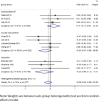Impact of fixed appliance treatment on root resorption in root canal-treated teeth: a systematic review and meta-analysis
- PMID: 40392039
- PMCID: PMC12138387
- DOI: 10.2340/aos.v84.43642
Impact of fixed appliance treatment on root resorption in root canal-treated teeth: a systematic review and meta-analysis
Abstract
Objective: The relationship between orthodontic treatment and root resorption in endodontically treated teeth remains controversial. This systematic review and meta-analysis aimed to evaluate the effects of fixed appliance treatment on root resorption in root canal-treated teeth compared to vital teeth.
Methods: A comprehensive literature search was conducted across multiple databases including PubMed, Embase, Cochrane Library, Web of Science, Sinomed, CNKI, and Wanfang. Studies comparing root resorption between root canal-treated teeth and vital teeth during orthodontic treatment were included. The methodological quality was assessed using the Cochrane risk of bias tool. Standardized mean differences (SMD) with 95% confidence intervals (CI) were calculated using random-effects models.
Results: Ten studies involving 266 patients met the inclusion criteria. The overall effect showed no significant difference in root resorption between root canal-treated teeth and vital teeth (SMD = -0.08, 95% CI: -0.24 to 0.08, I² = 7.0%). Subgroup analyses revealed no significant differences based on measurement methods, extraction versus non-extraction treatment, or tooth position. However, extraction cases demonstrated a numerical trend toward greater root resorption in root canal-treated teeth (SMD = -0.70, 95% CI: -1.50 to 0.11, I² = 67.1%, p = 0.048), while the non-extraction group showed no meaningful differences (SMD = -0.07, 95% CI: -0.42 to 0.28, I² = 49.2%, p = 0.096).
Conclusions: This meta-analysis suggests that root canal-treated teeth do not show significantly different root resorption patterns compared to vital teeth during orthodontic treatment. However, extraction cases may require careful monitoring due to a tendency toward increased root resorption.
Conflict of interest statement
All of the authors had no personal, financial, commercial, or academic conflicts of interest separately.
Figures








Similar articles
-
Root resorption of endodontically treated teeth following orthodontic treatment: a meta-analysis.Clin Oral Investig. 2013 Sep;17(7):1733-44. doi: 10.1007/s00784-012-0860-8. Epub 2012 Oct 12. Clin Oral Investig. 2013. PMID: 23064975
-
Orthodontic-induced External Root Resorption of Endodontically Treated Teeth: A Meta-analysis.J Endod. 2019 May;45(5):483-489. doi: 10.1016/j.joen.2019.02.001. Epub 2019 Mar 21. J Endod. 2019. PMID: 30904319
-
CBCT-based assessment of apical root resorption and alveolar bone height following orthodontic treatment of Class I moderate crowding with labial vs. lingual fixed appliances in young adults: A randomized controlled trial.Int Orthod. 2025 Jun;23(2):100968. doi: 10.1016/j.ortho.2025.100968. Epub 2025 Jan 20. Int Orthod. 2025. PMID: 39837069 Clinical Trial.
-
Root resorption in orthodontic treatment with clear aligners: A systematic review and meta-analysis.Orthod Craniofac Res. 2019 Nov;22(4):259-269. doi: 10.1111/ocr.12337. Epub 2019 Aug 29. Orthod Craniofac Res. 2019. PMID: 31323701
-
Orthodontically induced root resorption in endodontically treated and vital teeth: a cone beam computer tomographic study.Prog Orthod. 2025 Feb 27;26(1):8. doi: 10.1186/s40510-025-00553-7. Prog Orthod. 2025. PMID: 40011294 Free PMC article.
References
-
- Attavar S. An overview of the antimicrobial effect of natural irrigants in disinfection of root canal system. Pharmacophore. 2022;13(1):79–82. 10.51847/PpJg04CzT9 - DOI
Publication types
MeSH terms
LinkOut - more resources
Full Text Sources
Miscellaneous

